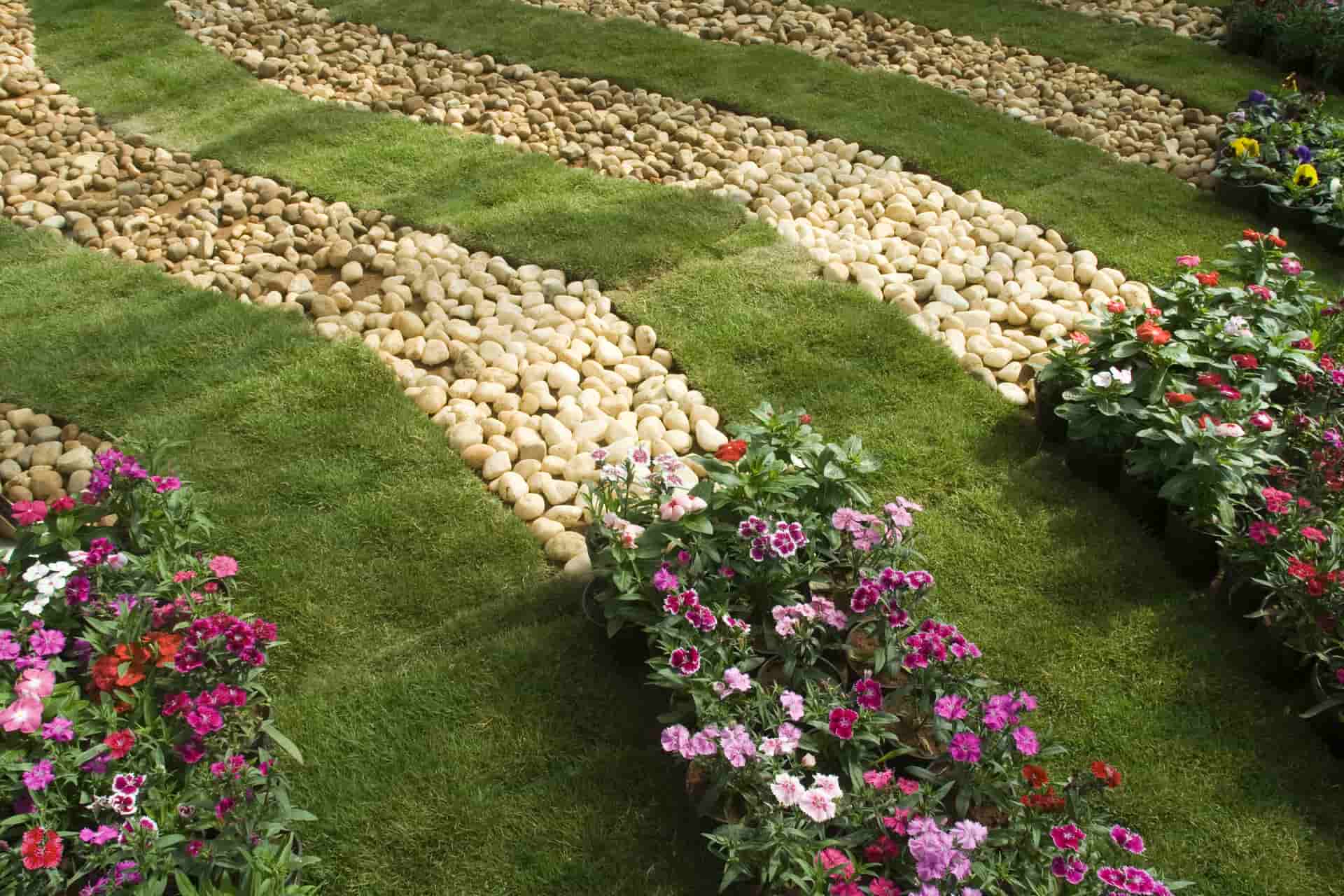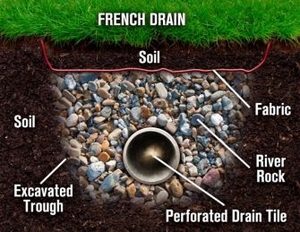
How Does a French Drain Work?
French drains may sound fancy, but in reality, they are pretty simple. A French drain works to solve drainage problems in your yard, making sure water flows where it needs to go. But what makes it a solution for standing water in your yard or excess water in your basement?
Keep reading to find out!
Purpose of French Drains
A French drain system helps direct ground and surface water away from your home to protect its foundation. Also, French drains will protect your yard, septic system drain field, and behind retaining walls by directing groundwater flow away from those areas.
French drains are ditches with a perforated pipe that run underground to direct water away from an area. This excavated area is also usually lined with gravel and collects water at ground level. This drainage system is also often used for basement waterproofing, rerouting water from foundations (which often happens when neighboring land has a higher slope than yours).
Types of French Drains
There are many French drains available today. These generally require a slope of 1 inch per 8 feet of length and must be at least 12 inches wide. Below are a few French drain types to consider.
Interior French Drain
Interior French drains are another great option to use if you are noticing water in your basement, particularly if you already have adequate outdoor drainage. Interior French drains are around the perimeter of your basement floor and move collected water away as it enters your basement.
This system captures water from the wall-floor joints and transfers it to a sump pump, dispersing it to the storm drain.
Interior French Drain Pros and Cons
Pros:
- Interior French drains are less expensive to install than exterior French drains.
- The installation process is easier and quicker.
- Installation is much less invasive.
Cons:
- Interior French drains require a sump pump (which uses electricity).
- Interior French drains may not prevent water from entering through your foundation walls and ruining your interior items.
- Interior French drains are more of a remedial solution.
Exterior French Drain
Homeowners install exterior French drain systems around the perimeter of a home's foundation to help reduce pressure by draining excess water from the surrounding soil. An exterior French drain is a viable option for those who already have adequate indoor drainage.
As the water pools around the foundation walls (and sometimes a retaining wall), it flows to a drainpipe, which directs it to a sump pump or uses gravity to drain it.
Exterior French Drain Pros and Cons
Pros:
- There is little to no disruption to interior items in the basement (furniture, things in storage, etc.).
- This drain can usually function using gravity rather than a sump pump.
- You will not have to deal with a sloppy, soggy lawn.
Cons:
- Contractors will need to excavate the area surrounding your foundation (which can get pretty messy).
- Regular service is invasive because you must excavate the site required to access the drain.
- These drains are much more expensive than interior drains.
Deep French Drain
A deep French drain also referred to as a "footing drain," is 6 feet under the ground or more (depending on your basement's depth). This drain will run the perimeter of your home and collect water before it can get into your basement.
Shallow French Drain
A shallow French drain (also known as a curtain drain) only needs to be around 2 feet deep and 1.5 feet wide. This drain extends horizontally across your yard to direct surface water away from a specific area.
French Drain Alternative
You can also use the following alternatives if you do not think a French drain is right for you:
- Valleys. A trench diverts water without the use of pipes
- Steps. Stairs on your property can help the water drain downhill
- Dry Wells. An underground structure collects water and directs it to a different location
- Garden. Plants can help soak up excess water

How Does a French Drain Work?
A French drain involves digging a trench with a designated slope. Then, you fill the trench with stone and landscaping fabric. Next, put perforated drain pipes at the lowest point and wrap them in filter fabric to prevent dirt, roots, and debris from blocking water to flow through the perforated holes. Last, add a few inches of gravel trench fill.
Water enters the trench and flows into the pipe, which will then move water to another area.
Will a French Drain Prevent Water in a Basement?
Yes, it can collect and redirect water by:
- Alleviating pressure on the foundation walls and collecting water in an exterior system
- Capturing incoming water from the wall-floor joists in an interior system
Do French Drains Work?
Yes, they can be effective. However, French drains may not be as effective in the following circumstances:
- If you are redirecting large amounts of water within a short amount of time
- If you have little to no slope on your property
- If your contractor does not correctly install them (incorrect depth, slope, perforation placement, and protection from dirt and debris)
- If you are using the wrong sized gravel
French Drains Maintenance
Over time, debris can block a French drainpipe. So, you will need to regularly clean the inside of the pipes (usually around once per year). Also, clear away any debris building up near the pipe on the outside, as this can prevent water from flowing out.
How Can You Tell If French Drain Is Working?
Here are a few steps you can take to see if your French drain is working correctly:
- Check your lawn for surface water
- Check your basement walls for moisture, mold, or dripping water
- Dig through the gravel that is covering the pipe and check for signs of flooding or leaking
- Examine the drain's endpoint, such as a well or gutter. (Use a water hose to direct water into the drain and see if the water flows out of the pipe or not)
- Check the drain for cracks and other damage
- See if there is any debris near the pipe itself
How Long Do French Drains Last?
The typical lifespan of a French drain is 8-10 years.
Cost to Install French Drain
Installing a French drain generally costs between $2,800 to $6,500, with the average being $4,500, including labor and the necessary materials. You can expect to pay more depending on the accessibility and size of the area.
In Yard
If you want a French drain in your yard, you can expect to pay around $20-$30 per linear foot.
In Basement
Installing basement drainage systems typically costs anywhere from $60 to $70 per linear foot.
Does Home Insurance Cover French Drains?
Most standard homeowners insurance policies (HO3) do not protect French drains, as they are not directly part of your home. However, you can opt to purchase a water backup endorsement, sewer line endorsement, or service line endorsement that may cover your French drain. The service line endorsement is the one that will most likely include French drains.
Are you looking for a policy or add-on that can cover your French drain? We would be happy to help you find the coverage you need. We invite you to work with one of our licensed insurance agents and get a free home insurance quote.
Hope that helps!
Free Online Home Insurance Quotes
At your service,
Young Alfred